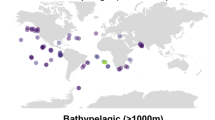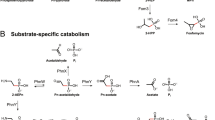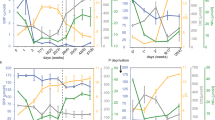Abstract
Phosphorus (P) is a vital nutrient for all living organisms and may control the growth of bacteria in the ocean. Bacteria induce alkaline phosphatases when inorganic phosphate (Pi) is insufficient to meet their P-requirements, and therefore bulk alkaline phosphatase activity measurements have been used to assess the P-status of microbial assemblages. In this study, the molecular basis of marine bacterial phosphatases and their potential role in the environment were investigated. We found that only a limited number of homologs to the classical Escherichia coli alkaline phosphatase (PhoA) were present in marine isolates in the Bacteroidetes and γ-proteobacteria lineages. In contrast, PhoX, a recently described phosphatase, was widely distributed among diverse bacterial taxa, including Cyanobacteria, and frequently found in the marine metagenomic Global Ocean Survey database. These taxa included ecologically important groups such as Roseobacter and Trichodesmium. PhoX was induced solely upon P-starvation and accounted for approximately 90% of the phosphatase activity in the model marine bacterium Silicibacter pomeroyi. Analysis of the available transcriptomic datasets and their corresponding metagenomes indicated that PhoX is more abundant than PhoA in oligotrophic marine environments such as the North Pacific Subtropical Gyre. Those analyses also revealed that PhoA may be important when Bacteroidetes are abundant, such as in algal bloom episodes. However, PhoX appears to be much more widespread. Its identification as a gene that mediates organic P acquisition in ecologically important groups, and as a marker of Pi-stress, constitutes an important step toward a better understanding of the marine P cycle.
Similar content being viewed by others
Log in or create a free account to read this content
Gain free access to this article, as well as selected content from this journal and more on nature.com
or
Accession codes
Accessions
GenBank/EMBL/DDBJ
References
Bauer M, Kube M, Teeling H, Richter M, Lombardot T, Allers E et al. (2006). Whole genome analysis of the marine Bacteroidetes Gramella forsetii reveals adaptations to degradation of polymeric organic matter. Environ Microbiol 8: 2201–2213.
Bengis-Garber C, Kushner DJ . (1982). Role of membrane-bound 5′-nucleotidase in nucleotide uptake by the moderate halophile Vibrio costicola. J Bacteriol 149: 808–815.
Clark LL, Ingall ED, Benner R . (1998). Marine phosphorus is selectively remineralized. Nature 393: 426.
Cotner JB, Ammerman JW, Peele ER, Bentzen E . (1997). Phosphorus-limited bacterioplankton growth in the Sargasso Sea. Aquat Microb Ecol 13: 141–149.
Dufresne A, Garczarek L, Partensky F . (2005). Accelerated evolution associated with genome reduction in a free-living prokaryote. Genome Biol 6: R14.
Dyhrman ST, Chappell PD, Haley ST, Moffett JW, Orchard ED, Waterbury JB et al. (2006). Phosphonate utilization by the globally important marine diazotroph Trichodesmium. Nature 439: 68–71.
Frias-Lopez J, Shi Y, Tyson GW, Coleman ML, Schuster SC, Chisholm SW et al. (2008). Microbial community gene expression in ocean surface waters. Proc Natl Acad Sci USA 105: 3805–3810.
Gilbert JA, Field D, Huang Y, Edwards R, Li W, Gilna P et al. (2008). Detection of large numbers of novel sequences in the metatranscriptomes of complex marine microbial communities. PLoS ONE 3: e3042.
Giovannoni SJ, Tripp HJ, Givan S, Podar M, Vergin KL, Baptista D et al. (2005). Genome streamlining in a cosmopolitan oceanic bacterium. Science 309: 1242–1245.
Guindon S, Gascuel O . (2003). A simple, fast, and accurate algorithm to estimate large phylogenies by maximum likelihood. Syst biol 52: 696–704.
Heidelberg JF, Eisen JA, Nelson WC, Clayton RA, Gwinn ML, Dodson RJ et al. (2000). DNA sequence of both chromosomes of the cholera pathogen Vibrio cholerae. Nature 406: 477–483.
Hernandez I, Hwang SJ, Heath RT . (1996). Measurement of phosphomonoesterase activity with a radiolabelled glucose-6-phosphate. Role in the phosphorus requirement of phytoplankton and bacterioplankton in a temperate mesotrophic lake. Arch Hydrobiol 137: 265–280.
Hoppe HG . (2003). Phosphatase activity in the sea. Hydrobiologia 493: 187–200.
Karl DM, Björkman KM, Dore JE, Fujieki L, Hebel DV, Houlihan T et al. (2001). Ecological nitrogen-to-phosphorus stoichiometry at station ALOHA. Deep Sea Res Part II Top. Stud Oceanogr 48: 1529–1566.
Kim EE, Wyckoff HW . (1991). Reaction mechanism of alkaline phosphatase based on crystal structures. Two-metal ion catalysis. J Mol Biol 218: 449–464.
Lohan MC, Statham PJ, Crawford DW . (2002). Total dissolved zinc in the upper water column of the subarctic North East Pacific. Deep Sea Res Part II Top. Stud. Oceanogr. 49: 5793–5808.
Majumdar A, Ghatak A, Ghosh RK . (2005). Identification of the gene for the monomeric alkaline phosphatase of Vibrio cholerae serogroup O1 strain. Gene 344: 251–258.
Mills MM, Ridame C, Davey M, La Roche J, Geider RJ . (2004). Iron and phosphorus co-limit nitrogen fixation in the eastern tropical North Atlantic. Nature 429: 292–294.
Monds RD, Newell PD, Schwartzman JA, O’Toole GA . (2006). Conservation of the Pho regulon in Pseudomonas fluorescens Pf0-1. Appl Environ Microbiol 72: 1910–1924.
Moran MA, Belas R, Schell MA, Gonzalez JM, Sun F, Sun S et al. (2007). Ecological genomics of marine Roseobacters. Appl Environ Microbiol 73: 4559–4569.
Morel FMM, Price NM . (2003). The biogeochemical cycles of trace metals in the oceans. Science 300: 944–947.
Nystrom T, Flardh K, Kjelleberg S . (1990). Responses to multiple-nutrient starvation in marine Vibrio sp. strain CCUG 15956. J Bacteriol 172: 7085–7097.
Polz MF, Hunt DE, Preheim SP, Weinreich DM . (2006). Patterns and mechanisms of genetic and phenotypic differentiation in marine microbes. Phil Trans R Soc B 361: 2009–2021.
Rocap G, Larimer FW, Lamerdin J, Malfatti S, Chain P, Ahlgren NA et al. (2003). Genome divergence in two Prochlorococcus ecotypes reflects oceanic niche differentiation. Nature 424: 1042–1047.
Roy NK, Ghosh RK, Das J . (1982). Monomeric alkaline phosphatase of Vibrio cholerae. J Bacteriol 150: 1033–1039.
Rusch DB, Halpern AL, Sutton G, Heidelberg KB, Williamson S, Yooseph S et al. (2007). The sorcerer II global ocean sampling expedition: Northwest Atlantic through eastern tropical Pacific. PLoS Biol 5: e77.
Scanlan DJ, Wilson WH . (1999). Application of molecular techniques to addressing the role of P as a key effector in marine ecosystems. Hydrobiologia 401: 149–175.
Su Z, Olman V, Xu Y . (2007). Computational prediction of Pho regulons in cyanobacteria. BMC Genomics 8: 156.
Thingstad TF, Krom MD, Mantoura RFC, Flaten GAF, Groom S, Herut B et al. (2005). Nature of phosphorus limitation in the ultraoligotrophic Eastern Mediterranean. Science 309: 1068–1071.
Van Mooy BAS, Devol AH . (2008). Assessing nutrient limitation of Prochlorococcus in the North Pacific subtropical gyre by using an RNA capture method. Limnol Oceanogr 53: 78–88.
Van Mooy BAS, Rocap G, Fredricks HF, Evans CT, Devol AH . (2006). Sulfolipids dramatically decrease phosphorus demand by picocyanobacteria in oligotrophic marine environments. Proc Natl Acad Sci 103: 8607–8612.
van Mourik A, Bleumink-Pluym NMC, van Dijk L, van Putten JPM, Wosten MMSM . (2008). Functional analysis of a Campylobacter jejuni alkaline phosphatase secreted via the Tat export machinery. Microbiology 154: 584–592.
Van Wambeke F, Christaki U, Giannokourou A, Moutin T, Souvemerzoglou K . (2002). Longitudinal and vertical trends of bacterial limitation by phosphorus and carbon in the Mediterranean Sea. Microb Ecol 43: 119–133.
von Kruger WMA, Lery LMS, Soares MR, de Neves-Manta FS, Silva C, Neves-Ferreira AGD et al. (2006). The phosphate-starvation response in Vibrio cholerae O1 and phoB mutant under proteomic analysis: disclosing functions involved in adaptation, survival and virulence. Proteomics 6: 1495–1511.
Wagner-Dobler I, Biebl H . (2006). Environmental biology of the marine Roseobacter lineage. Annu Rev Microbiol 60: 255–280.
Wanner BL . (1996). Phosphorus assimilation and control of the phosphate regulon. In: Neidhardt FC (ed). Escherichia and Salmonella: Cellular and Molecular Biology. ASM Press: Washington, DC, pp 1357–1381.
Wu J, Sunda W, Boyle EA, Karl DM . (2000). Phosphate depletion in the Western North Atlantic ocean. Science 289: 759–762.
Wu J-R, Shien J-H, Shieh HK, Hu C-C, Gong S-R, Chen L-Y et al. (2007). Cloning of the gene and characterization of the enzymatic properties of the monomeric alkaline phosphatase (PhoX) from Pasteurella multocida strain X-73. FEMS Microbiol Lett 267: 113–120.
Acknowledgements
We thank the captain and the crew of the R/V Atlantic Explorer for assistance with Sargasso sea sampling; J Sylvan for providing the Chesapeake Bay sample; MA Moran (U Georgia) and R Blakenship (Washington University, St Louis) for providing the cultures of S. pomeroyi and R. denitrificans, respectively; J Sylvan, L McGuiness and C Vetriani for their advice on molecular techniques; K Thamatrakoln for helping in the development of the knockouts; L Kerkhof, P Falkowski and K Bidle for equipment access; and D Rusch for the help with bioinformatics. We also thank Y Helman, A Vardi, K Thamatrakoln and K Bidle for their comments on the manuscript. This study was supported in part by a postdoctoral fellowship from the Spanish Ministry of Education (to MS), a Marie Curie Outgoing European Fellowship (to MS) and a grant from NSF Biological Oceanography Program.
Author information
Authors and Affiliations
Corresponding author
Additional information
Supplementary Information accompanies the paper on The ISME Journal website (http://www.nature.com/ismej)
Supplementary information
Rights and permissions
About this article
Cite this article
Sebastian, M., Ammerman, J. The alkaline phosphatase PhoX is more widely distributed in marine bacteria than the classical PhoA. ISME J 3, 563–572 (2009). https://doi.org/10.1038/ismej.2009.10
Received:
Revised:
Accepted:
Published:
Issue date:
DOI: https://doi.org/10.1038/ismej.2009.10
Keywords
This article is cited by
-
Enzymatic phosphatization of fish scales—a pathway for fish fossilization
Scientific Reports (2024)
-
Phosphorus availability on the early Earth and the impacts of life
Nature Geoscience (2023)
-
Screening of nanobody targeting alkaline phosphatase PhoX in Microcystis and detection of the PhoX in situ by fluorescence immunoassays
Journal of Applied Phycology (2023)
-
Structure and Functional Properties of Bacterial Communities in Surface Sediments of the Recently Declared Nutrient-Saturated Lake Villarrica in Southern Chile
Microbial Ecology (2023)
-
PCycDB: a comprehensive and accurate database for fast analysis of phosphorus cycling genes
Microbiome (2022)



